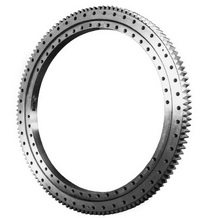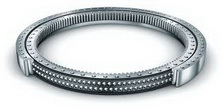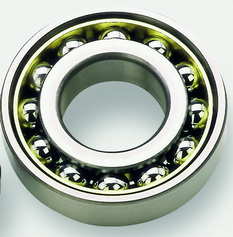Four-point contact ball slewing bearing is composed of 2 seat-rings, if features compact in design, and light in weight. The balls contact with the circular race at four points, via which the axial force, radial force and resultant moment maybe born simultaneously.
Sidebar
The Double-Row Ball Slewing Ring has three seat-rings. Steel Balls and Spacers may be poured directly into upper and nether orbits. Two rows of upper and nether Steel Balls of different diameters can be assembled according to Undertaking Power situation. The kind of open-pattern-assembly is very convenience. The load-angles of both upper and nether circular orbits are 90 degree, which enable it to undertake very large Axial Force and Tipping moment. When the Radial Force is more than 0.1 multiple of Axial Force, the orbit need to be redesigned. As the axial and radial size of this kind of slewing ring are rather big, and the structure is firm, it is especially suitable for Tower Cranes of over-medium diameter, Truck Cranes, Loading and Unloading Machines, and so on.
The deep groove ball bearings have simple structure and easy to use, also, the application scope is broad. Such bearings are mainly used to bear the radial load, also can bear the axial load.when the radial clearance is increasing,it can have the performance of angular contact ball bearings,and can bear the larger axial load. Compare to the other bearings of the same dimensions, the friction loss of the bearing is minimum and the limit speed is maximum. When under higher speed ,the thrust ball bearings can not be used,while, the deep groove ball bearings should be adopted to bear pure axial load.
Most of the cages of deep groove ball bearing are pressed steel plate cage,but large bearings use machined solid cage.
Angular contact ball bearing have high limit rotational speed, they can carry radial load and axial load simultaneously, they cal also withstand purely radial load. The axial load carrying capacity depends on the magnitude of contact angle and increases with increasing contact angle.




